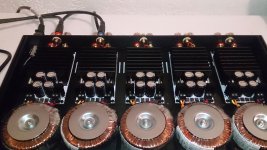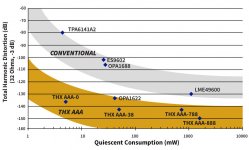This thread is down?
Just to mention that both LME49600 and LME49990 are back in stock, on farnell and RS at least. As I don't know if PCB are still availables, (I've asked OPC but get no answer), I'm planning building and "modding" on my own 😱
Just a few minor changes, almost on the PSU. I'm a newbie on Kicad so it will take some time ! I'll use these amps on AMT tweeters in an active 3 ways so I'll add a high-pass to cut the 50Hz noise. I'll also change all the 10uF decoupling for 4.7uF + 0.1uF. As I'm SE I put only one 49990 before the 49600. And regulators will be LM350.
Anyway thanks Owen for the reference design/measurements/BOM and these 75 pages of support 😛
Cheers!
Just to mention that both LME49600 and LME49990 are back in stock, on farnell and RS at least. As I don't know if PCB are still availables, (I've asked OPC but get no answer), I'm planning building and "modding" on my own 😱
Just a few minor changes, almost on the PSU. I'm a newbie on Kicad so it will take some time ! I'll use these amps on AMT tweeters in an active 3 ways so I'll add a high-pass to cut the 50Hz noise. I'll also change all the 10uF decoupling for 4.7uF + 0.1uF. As I'm SE I put only one 49990 before the 49600. And regulators will be LM350.
Anyway thanks Owen for the reference design/measurements/BOM and these 75 pages of support 😛
Cheers!
I am interested in getting boards as well however had no response so far. Looks like I will have to Kicad my own version as well.
depends if you change the input resistor and if you have a volume control in front of the SE amp. Mine is around 15k.
Hi,
I would like to know if there is a difference between normal and over-volt (18=>22v, for 16ohm speaker) version in therms of THD and thermal dissipation.
Thanks
I would like to know if there is a difference between normal and over-volt (18=>22v, for 16ohm speaker) version in therms of THD and thermal dissipation.
Thanks
it runs a bit warmer, dont know about any distortion differences as I cannot measure that low, and you get a bit more head room. The chips will run warmer with or with out any load. When I built the board I was worried about soldering errors with 8 chips in parallel. So I made the board installing one buffer chip at a time and testing into a 4 ohm load. I then ran sine waves and noted when the output went into current limiting ie clipping. As I added each chip the clipping level would increase. I cant remember the exact values but it might have been something like 3 volts PP with one chip then higher with each additional chip soldered in. Still works and sound great!
done a pair of those
slightly different from OPC design but I used his board.
added a DC servo s well.
they are the best diy amp I have ever done and few friends immediately asked me to build them a pair as well
those are good.
slightly different from OPC design but I used his board.
added a DC servo s well.
they are the best diy amp I have ever done and few friends immediately asked me to build them a pair as well
those are good.
You mean using THX instead of LME?
Very interesting, especially with those particular LME being NLA now!
I had no idea it could be integrated in the current design.
What THX AAA model did you choose?
Very interesting, especially with those particular LME being NLA now!
I had no idea it could be integrated in the current design.
What THX AAA model did you choose?
I dont believe you can use the THX chips in the same design as OPC's. The THX spec is a max 5.5Vdc supply voltage, 2 channels per chip. here is a link to the THX chip. I dont see any mention of a THX-AAA888. The big drawback for us old fat fingered half blind diy fellows is the chip is 2.5 x 2.5 mm, 25 bump wafer!
you will need a complete new design
TSTHX88 Amplifier IC - Triad Semiconductor
you will need a complete new design
TSTHX88 Amplifier IC - Triad Semiconductor
Hi pos,
Those parts are indeed interesting, and I appreciate the link! As multisync mentioned, they would not be a good candidate for the LPUHP due to the low maximum voltage, and dual channel / integrated design.
I'm also highly skeptical of the claims being made, especially since there are no measurements provided at all, and the "module" shown in the pictures I can find does not at all resemble a 25-bump WCSP. They make no mention of the measurement conditions, and the chart they provided doesn't really make much sense. They are comparing their part to the LME49600 which is a buffer, and fundamentally not the same thing as what they are pitching.
The LME49990 is rated at -140dB THD+N and a measurement is provided on the first page of the datasheet. The chart from THX claims -150dB THD only for the THX AAA-888. I would imagine the actual THD+N would fall well below what the LME49990 is capable of, especially considering the limited output voltage capabilities of the THX parts.
What all this means in the real world is probably moot. If I were to market the LPUHP in the same way THX seems to be marketing these parts, I would print the graph from the datasheet of the LME49990, claim "-140db THD+N!" and be done. Getting datasheet specified performance from a finished product is not so trivial, and it's generally misleading to imply a product has a given level of performance simply because it contains a part that has that performance under lab conditions. It will be interesting to see actual measurements when these products hit the market. If anyone wants to loan me one I'd be happy to measure it 🙂
Regards,
Owen
Those parts are indeed interesting, and I appreciate the link! As multisync mentioned, they would not be a good candidate for the LPUHP due to the low maximum voltage, and dual channel / integrated design.
I'm also highly skeptical of the claims being made, especially since there are no measurements provided at all, and the "module" shown in the pictures I can find does not at all resemble a 25-bump WCSP. They make no mention of the measurement conditions, and the chart they provided doesn't really make much sense. They are comparing their part to the LME49600 which is a buffer, and fundamentally not the same thing as what they are pitching.
The LME49990 is rated at -140dB THD+N and a measurement is provided on the first page of the datasheet. The chart from THX claims -150dB THD only for the THX AAA-888. I would imagine the actual THD+N would fall well below what the LME49990 is capable of, especially considering the limited output voltage capabilities of the THX parts.
What all this means in the real world is probably moot. If I were to market the LPUHP in the same way THX seems to be marketing these parts, I would print the graph from the datasheet of the LME49990, claim "-140db THD+N!" and be done. Getting datasheet specified performance from a finished product is not so trivial, and it's generally misleading to imply a product has a given level of performance simply because it contains a part that has that performance under lab conditions. It will be interesting to see actual measurements when these products hit the market. If anyone wants to loan me one I'd be happy to measure it 🙂
Regards,
Owen
Hey Owen old buddy. The usual suspects had lunch yesterday at the usual place and if you are in the neighbourhood on April 7th we will be getting together at the usual place doing the same usual things. Listening to music and showing off our recent attempts at hifi.
johnk
johnk
Considering that the input ground will be common for both channels, I can combine the output grounds and it won't smoke up?
Would this be called "bridged output?
Would this be called "bridged output?
Last edited:
no not bridged
each board of the LPUHP amp is one channel and the output of each amplifier is single ended and not bridged. IF you want to bridge the amplifier you will need 4 of the LPUHP amplifiers. OPC did make some bridged or balanced headphone amplifiers. He also had a bridged version of the LPUHP to give 50 watts RMS output into 8 ohms using 32? chips in bridge parallel. THese were not available for sale. A few demo versions were made.
you should be able to connect the output grounds without magic smoke. The input grounds will be tied together right? Are your headphones 4 wire capable? Are you using the balanced input connection or single ended input?
some people have reported a lot of hum. A solution that worked for me was to use a large diameter wire 14 Gage between the two speaker grounds and use a point in the middle of that wire to connect to the speakers negative terminal.
each board of the LPUHP amp is one channel and the output of each amplifier is single ended and not bridged. IF you want to bridge the amplifier you will need 4 of the LPUHP amplifiers. OPC did make some bridged or balanced headphone amplifiers. He also had a bridged version of the LPUHP to give 50 watts RMS output into 8 ohms using 32? chips in bridge parallel. THese were not available for sale. A few demo versions were made.
you should be able to connect the output grounds without magic smoke. The input grounds will be tied together right? Are your headphones 4 wire capable? Are you using the balanced input connection or single ended input?
some people have reported a lot of hum. A solution that worked for me was to use a large diameter wire 14 Gage between the two speaker grounds and use a point in the middle of that wire to connect to the speakers negative terminal.
- Home
- Amplifiers
- Solid State
- The Wire - Low Power Ultra High Perfromance (LPUHP) 16W Power Amplifier

